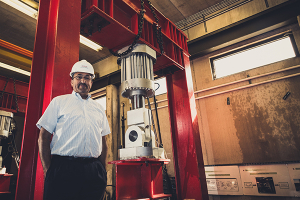A civil infrastructure that provides essentials like clean running water and passable roads is essential to a healthy and prosperous society. While concrete and steel remain the backbones of modern infrastructure, civil engineers are exploring ways to add advanced composite materials to the mix. These materials could increase the service life of existing structures in need of repair and new structures alike by decades.
Before structural engineers can include these materials in roads and bridges, though, they must know exactly how to use them. While composites have long been used in the automotive and aerospace industries, design guidelines and specifications that outline how to use composites in infrastructure must be written.
“If you just tell the engineering community that there is a very nice new material they should use, it’s not going to happen,” said DJ Belarbi, distinguished professor of civil and environmental engineering with the University of Houston Cullen College of Engineering. “You need to test these materials and create a set of design specifications that explain how they should be used.”
That’s exactly the task Belarbi and his colleagues Mina Dawood and Bora Gencturk, both assistant professors in civil and environmental engineering, have taken up. The team is developing design guidelines and specifications for the use of prestressed carbon fiber reinforced polymers (CFRPs) in the construction of new bridges. To conduct this work, they recently won a three-year, $500,000 grant from the National Cooperative Highway Research Program, a group administered by the National Academy of Sciences and voluntarily funded by state transportation boards.
Depending on their particular makeup, CFRPs are not only stronger than steel, but they may also eliminate corrosion problems associated with prestressed steel – widely viewed as the biggest contributor to premature infrastructure deterioration.
CFRP systems can offer additional advantages by being prestressed. Essentially, they are pulled tight and then surrounded by wet concrete poured into a mold. When the concrete hardens, the CFRPs are released, literally pulling the concrete together before the structures are placed in service. This pre-compression, said Belarbi, helps limit superstructure deformations as well as the formation of cracks. The greater durability generated by CFRP prestressing systems allows for the construction of longer span bridges and the more efficient use of materials.
While this process is well understood, exactly how much strength different CFRPs confer on concrete bridge elements and how they should be used in new construction must be determined.
To create these design specifications, Belarbi and his team will begin with a review of all published research on CFRPs, identifying gaps in the research along the way. They will then simulate the effect of traffic load on concrete bridge girders (measuring at least 40 feet) that contain CFRPs. Ultimately these bridge components will be brought to failure using sophisticated testing equipment that applies hundreds of tons of force in both monotonic loading (where a steadily increasing load is applied) and fatigue loading (where millions of load cycles are applied and then removed). Girder components will also be placed in an environmental chamber, where in just a few days they’ll be exposed to a year’s worth of heat, cold, rain, humidity, and more. During and after each test they will be examined for defects and overall serviceability.
With this information, Belarbi and his team will write design specifications for bridges using CFRP-reinforced concrete. These specifications almost certainly will be adopted as part of the official design code published by the American Association of State Highway and Transportation Officials (AASHTO). This code, Belarbi stated, is used by all state Departments of Transportation (DOTs) across the country to create binding rules for bridge design. Belarbi has previously written design specifications that were adopted by AASHTO covering the use of CFRP for external strengthening of bridge girders.
“Any time you get a new technology, you have to prove it,” said Belarbi. “You cannot put something like this in a long bridge and not know how it will behave. So our job is to create guide specifications so engineers can safely design concrete bridge girders that use prestressed CFRP systems. Once this project is completed, UH will have contributed to a major national need by supporting the creation of a durable and efficient civil infrastructure. “
